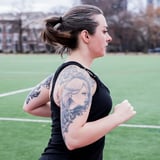

If your goal is to lose fat, especially around the belly, it's not (unfortunately) going to happen overnight. Nor can you specifically spot-reduce fat from around your belly area; you'll need to target body fat as a whole. Consistent diet and exercise play a role in this, but it's true that some workouts do burn fat faster and more efficiently than others. (Though you'll need to stick to a healthy diet, like this two-week clean eating plan, to be able to see those effects.)
Cardio Isn't the Fastest Way to Lose Belly Fat
So what's the best workout for burning fat, fast? You might think it's cardio - heart-pumping, sweat-inducing cardio like running, cycling, or swimming. But although cardio plays a big role in a healthy lifestyle, it's not the most effective way to shed fat. According to two trainers, that title goes to resistance training, especially the kind that involves high-intensity circuits.
The combination of high-intensity interval training (HIIT) and resistance training is seriously effective, according to certified personal trainer Ashley Kelly, NASM, who trains clients for Bach in New York City. Essentially, she told POPSUGAR, you're "performing a set of exercises designed to strengthen specific body parts, with little to no rest between exercises."
It's a pretty simple formula: you build muscle through strength training, either with weights or bodyweight exercises, and you max out your heart rate by doing it in fast, intense circuits. Or, as Angelo Grinceri, FAFS, head trainer at Performix House in NYC and Ladder personal training coach, puts it: "Resistance training with an elevated heart rate is the fastest way to lose fat." (Use this guide to calculate your target heart rate.)
Why Is HIIT Better Than Cardio For Burning Belly Fat?
What makes HIIT so much more effective? It comes down to the muscle-building aspect. Although cardio does wonders at getting your heart rate up, it doesn't engage or build muscles the way HIIT and resistance training does; in fact, cardio can actually break muscle down if you do too much of it without proper fuel.
With high-intensity resistance training, on the other hand, the whole point is to build muscle. Not only do you burn major calories throughout the workout, thanks to your elevated heart rate, but you'll also keep burning them throughout the day. "There is a direct correlation between an individual's muscle mass and how many calories he or she burns," Ashley told POPSUGAR. "Muscle burns fat even when you are resting." The more muscle you have, the higher your resting metabolic rate (RMR) and the more calories you'll burn even when you're 'chilling on the couch' sedentary," Ashley explained.
How Often Should You Do Resistance Training and Cardio to Burn Belly Fat?
What does all of this mean for your workout schedule? Both Ashley and Angelo recommended balancing your cardio and resistance training throughout the week, because even though cardio isn't the fastest way to burn fat, it's still majorly important for your overall health; a 2016 study from the Journal of Internal Medicine showed that cardio like walking, stair-climbing, cycling, and swimming decreases type 2 diabetes, some cancers, falls, osteoporotic fractures, and depression. Incorporating both cardio and resistance training also decreases your risk of injury.
Angelo said his clients have found fat-burning success by doing resistance training at least twice a week, alongside cardio workouts two to three times a week. Ashley's ideal schedule, depending on the person, upped the resistance training to three times a week, with two days of cardio and two rest days. They both agreed, though, that you should do at least 30 minutes of cardio, four to five days a week. "It doesn't have to be max effort," Angelo said. "But challenge yourself!"
Ready to get started? Grab some weights and head over to our four-week workout plan for weight loss and building muscle for the perfect balance of strength training and cardio.




0 comments :
Post a Comment